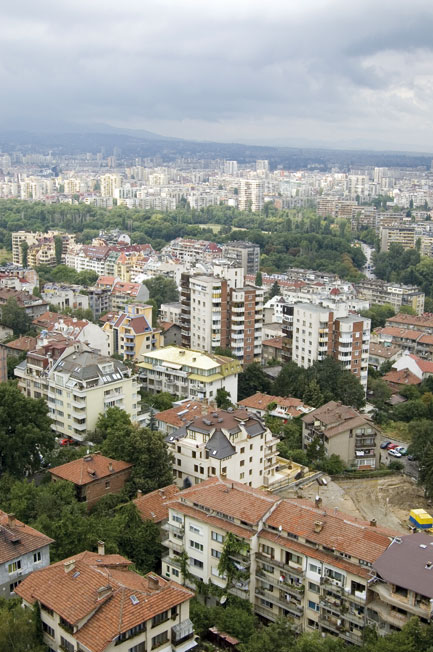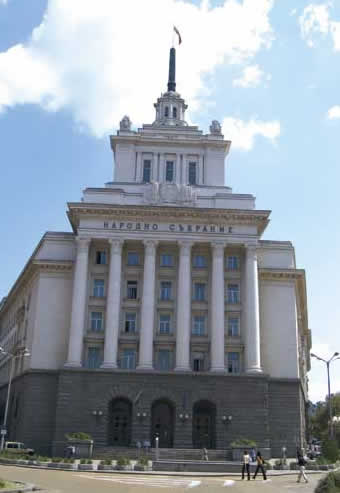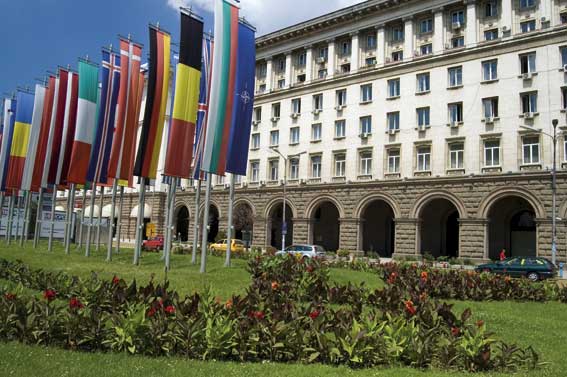
Travel

Bulgaria
Surprising Sofia
Located in southwest Bulgaria surprising Sofia is not only the country’s capital but also the geographical centre of the Balkan peninsula.
By: Veronica Maria Garbutt
The Sofia Plain is encircled by mountains - to the north the Balkan and to the south the Vitosha and Lyulin mountains. The area abounds with curative mineral springs. It comes as no surprise to learn that 550 metre high Sofia is Europe’s highest capital. A city of just over a million, the metropolis not only reflects the country’s turbulent past but also the challenges facing Bulgaria in the new era of the European Union.
The name Sofia means ‘grows but does not age’ and the city comes into its own on fine summer days when the pavement cafés are abuzz with life. Indeed the capital has a leafy, laid back atmosphere at this time. Byzantine ruins and Turkish mosques speak of a colourful past and the city’s main draw is the remarkable historic centre with its grandiose Stalin-era neo classic architecture along with buildings from Ottoman and National Revival periods. Sofia was founded in prehistoric times by the Serdii Tribe and was known as Thracian Serdica. It went through name changes including Roman Ulpia Serdica and Byzantine Traditsa before taking the name Sofia in the 14th century CE. In 1396 it became an Ottoman administrative centre and remained so for centuries. Independence came in 1879 and Sofia was chosen as capital of an independent Bulgaria.
There followed the Balkan wars with fighting mainly over Macedonia, then World War II. After a referendum in 1946 Bulgaria was declared a republic, the collectivisation of agriculture were carried out. On 9 November 1989 the Berlin Wall fell in Germany and by 1990 Bulgaria became independent again. Sofia has coped better with the transition to a market economy than most Bulgarian towns. New businesses have mushroomed and the city is emerging as a modern metropolis. 
On the economic front Bulgaria has long been a mainly agricultural country with most of the land dedicated to growing wheat, oats, corn, rye, sugar beet, cotton and tobacco. In the Sofia region the most developed sectors are metallurgy, machine tool engineering, metal processing, paper and textile industries plus food and drink processing. The capital offers several business centres including Prima (http://www.nchbg.com) and Prestige (http://www.businesspad-sofia.com). And the World Bank office is located at the World Bank Centre, 36 Dagan Tsankor Boulevard.
Located 10 km east of the city centre the two - terminal Sofia International has a 2.5 million passenger capacity. From there, it is a 15 Euro ride downtown by OK or SuperTrans taxi. A cheap and extensive public transport system operates around town with trams, buses, trolley buses and even a short subway section. The Central Railway Station offers services to Bulgaria’s main cities, towns and abroad. For a cab call OK Taxi at 973 2121 or Yes Taxi or 1 Euro Taxi at 962 2226.
Most of the important buildings, sights and commercial centres fit within a rough octagon bounded by the city’s inner ring road. This is the heart of the ancient settlement of Serdica, so you can gain a good impression of the ancient and modern on the same walk. The whole area is compact enough to explore on foot. A good starting point is the Sheraton Hotel on Sveta Nedemlya Square, built as are all the other edifices in the area in grey granite neo-classical style. Indeed the locality is a typical surviving example of 1950s Stalinist urban planning.
Across the grassy square bedecked with flags known as The Largo is the TSUM department store, modelled on GUM in Moscow. These days, it has become a mall of merchandise, home to several concessions selling all manner of clothing, jewellery, cosmetics, stationery, food and household goods. Nearby is the imposing Party House along with the Foreign Ministry and Office of the President. On the far side of the Largo, bul Knyaginya Mariya Luiza heads north passing the city’s principal mosque, Banya Bashi (Mosque of the Baths) and the main bath house.
Designed by the founding father of classical Islamic architecture, Sinan, the mosque was completed in 1576. Open from dawn to dusk, the interior is decorated with tracery of flora beneath a single whitewashed dome. Other features include a square prayer room, finely crafted wooden women’s gallery and some exquisite rugs. Outside are stalls selling Islamic literature and the adjacent mineral baths (hammam) boast a façade with finely inlaid mosaic. 
Across the boulevard lies the Hali Public Market which occupies a large square site with rows of arches and an arcaded interior. Back on the Largo you will come across a craft market with wood carvings, fine lace and musical instruments on sale. On the east side of the Largo stands the nine-domed former Buyuk Djami mosque which today houses the National Archeological Museum. It showcases a fine coin collection along with Roman mosaics and Thracian finds from across Bulgaria.
Running southeast from the Largo is Boulevard Tsar Osvoboditel, home to even more cultural institutions. First is the National Art Gallery which occupies one wing of the former Royal Palace, built in Palladian style. It displays some 12,000 artworks by 19th and 20th century Bulgarian masters. The adjacent Ethnographic Museum is home to an exceptional range of Bulgarian costumes, arts and crafts dating from the 1700s. Other museums in the area include the Natural History Museum, National Gallery of Foreign Art and the Ivan Vasov House – Museum.
Time now to take a break in tree shaded City Gardens, popular with lunching office workers and chess playing seniors. There are one or two teashops serving drinks and snacks and in summer time the pavement in front of the Neoclassical Ivan Vasov National Theatre becomes a gigantic outdoor café. It is a delightful place to while away a sunny afternoon reading a book or watching the world go by. And not far away lies Pl Narodne Sabranie, home to the elegant National Assembly whose motto is ‘Unity is Strength’.
Time now to head over to Vitosha Boulevard, the city’s most stylish shopping street. In summer the elegant tree-lined avenue is a fine place to pause for a coffee and more people-watching before strolling southwards to the NDK Place of Culture. Built in 1981 this striking landmark venue, often used for concerts and conferences, is surrounded by a park and gardens popular with cyclists, rollerbladers and families out for the afternoon . The basement shopping precinct is worth a visit, but even better, take the lift up to the top floor café for a bird’s eye view over the Bulgarian capital.
Bulgarian cuisine is heavily influenced by Greece and Turkey. In winter hearty soups such as bob (bean) or torcheta (meatball) are popular. Come summer it is time for shopska salad, made from cucumber, tomatoes, onion and grated white cheese. Peppers burek (stuffed with meat and rice) and lamb kavarna, slow cooked in a clay pot, are all time favourites. Fish from the Black Sea made into a plakiya stew is another noted dish, as is the local breakfast of banitza, cheese-filled pastry.On the restaurant scene try Vitosho or Pri Yafata fro native dishes with a cultural show. Rayamama serves Indian while Onar does excellent Lebanese and Greek food. If it is Moroccan food you are after, Annette is the place to head for. Mamma Mia does good Italian and Sky Dragon fine Chinese. Flannagans, an Irish restaurant, is a magnet for expatriates. It also serves English dishes and American style fast food. 
On the sports scene skiing, hiking, canoeing, riding, mountain biking, climbing, potholing and bird watching are possibilities. And over on the Black Sea coast all manner of watersports are on offer. Bulgarians are serious about their football and their league is one of Europe’s strongest. Two of the most successful teams are the Sofia-based CSKA and Levski. If you have time to spare, don’t miss exploring Sofia’s environs. Take the no. 66 bus to Mount Vitosha on the city’s south side. It is a nature reserve popular with walkers and skiers. Stop en route at Dragalevtski or Boyana village, favoured residential locations of the diplomatic corps and the elite business community. Both offer some of the best places to dine with traditional restaurants such as Casa Boyana offering folklore displays too. The Royal Place at Vrania set in atmospheric grounds in an interesting monument to the 19th century CE Bulgarian monarchy.
For a taste of provincial life jump on a train to Plovdiv. Bulgaria’s second city is a three hour ride from the capital through fields of wheat and tobacco and cherry and apple orchards. Within the old city are remains from Roman, medieval and Ottoman times. These include the fine Dzhumaiya Mosque, dating from the times of Sultan Murad II (1359-85) and the Roman amphitheatre, built in the 2nd century CE. With some of the finest examples of Bulgarian National Revival architecture, the area is a charming place to wander with museums, mansions, little shops and cafes on every corner.